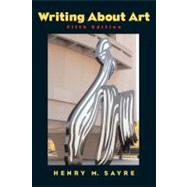
Note: Supplemental materials are not guaranteed with Rental or Used book purchases.
Purchase Benefits
What is included with this book?
| Illustrations | viii | ||||
| Preface | ix | ||||
| Acknowledgments | xi | ||||
| INTRODUCTION: The Process of Writing About Art | 1 | (14) | |||
|
6 | (6) | |||
|
12 | (3) | |||
| 1 CHOOSING IMAGES: How to Select the Works of Art You Plan to Write About | 15 | (18) | |||
|
15 | (7) | |||
|
22 | (2) | |||
|
24 | (3) | |||
|
27 | (3) | |||
|
30 | (1) | |||
|
31 | (2) | |||
| 2 USING VISUAL INFORMATION: What to Look For and How to Describe What You See | 33 | (35) | |||
|
35 | (3) | |||
|
38 | (20) | |||
|
38 | (2) | |||
|
40 | (4) | |||
|
44 | (2) | |||
|
46 | (4) | |||
|
50 | (8) | |||
|
58 | (5) | |||
|
58 | (1) | |||
|
59 | (1) | |||
|
60 | (1) | |||
|
61 | (1) | |||
|
62 | (1) | |||
|
63 | (3) | |||
|
66 | (1) | |||
|
66 | (2) | |||
| 3 RESPONDING TO THE VERBAL FRAME: Where Else to Look For Help in Understanding What You See | 68 | (30) | |||
|
68 | (4) | |||
|
72 | (2) | |||
|
74 | (2) | |||
|
76 | (8) | |||
|
77 | (2) | |||
|
79 | (4) | |||
|
83 | (1) | |||
|
84 | (6) | |||
|
90 | (8) | |||
|
90 | (1) | |||
|
91 | (1) | |||
|
92 | (5) | |||
|
97 | (1) | |||
| 4 WORKING WITH WORDS AND IMAGES: The Process of Writing About What You See | 98 | (28) | |||
|
98 | (1) | |||
|
99 | (14) | |||
|
101 | (2) | |||
|
103 | (3) | |||
|
106 | (5) | |||
|
111 | (2) | |||
|
113 | (8) | |||
|
113 | (3) | |||
|
116 | (2) | |||
|
118 | (1) | |||
|
119 | (2) | |||
|
121 | (5) | |||
| Appendix A SHORT GUIDE TO USAGE AND STYLE: The Rules and Principles of Good Writing | 126 | (14) | |||
|
127 | (1) | |||
|
127 | (1) | |||
|
128 | (1) | |||
|
129 | (1) | |||
|
129 | (1) | |||
|
129 | (1) | |||
|
130 | (1) | |||
|
130 | (1) | |||
|
130 | (1) | |||
|
131 | (1) | |||
|
131 | (1) | |||
|
132 | (1) | |||
|
132 | (1) | |||
|
133 | (1) | |||
|
133 | (1) | |||
|
134 | (1) | |||
|
134 | (1) | |||
|
135 | (1) | |||
|
135 | (1) | |||
|
136 | (1) | |||
|
136 | (1) | |||
|
137 | (1) | |||
|
137 | (1) | |||
|
138 | (1) | |||
|
138 | (2) | |||
| Notes | 140 | (3) | |||
| Index | 143 |
The New copy of this book will include any supplemental materials advertised. Please check the title of the book to determine if it should include any access cards, study guides, lab manuals, CDs, etc.
The Used, Rental and eBook copies of this book are not guaranteed to include any supplemental materials. Typically, only the book itself is included. This is true even if the title states it includes any access cards, study guides, lab manuals, CDs, etc.